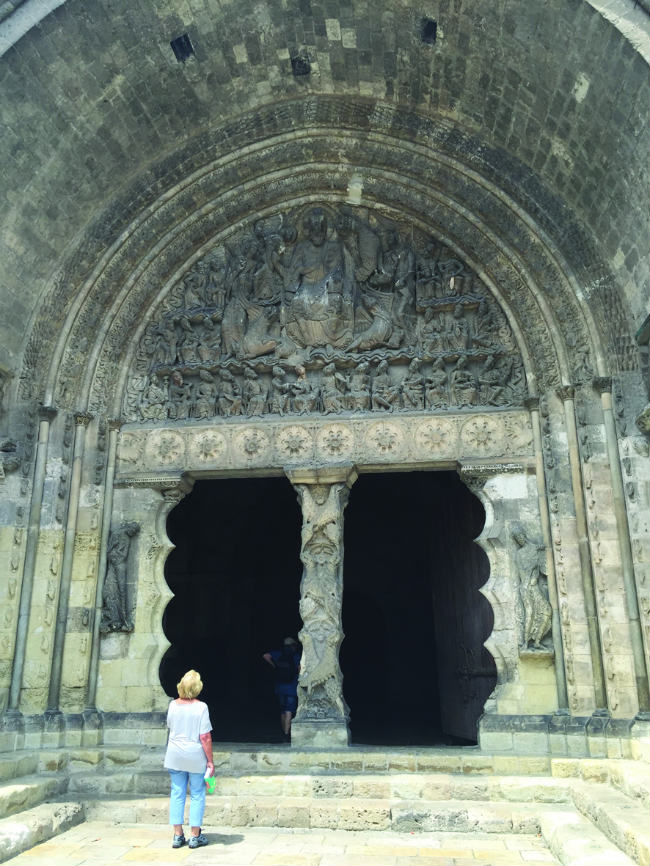France Holiday Ideas: The Heritage of Moissac

Boasting one of France’s most striking buildings and a monument to the benefits of eating grapes, Moissac in the Tarn-et-Garonne is a must-see for those with an interest in French history…
UVARIUM
One of the more unusual places in which to grab a spot of lunch in Moissac is amid the splendid Art Deco surroundings of the town’s former Uvarium – a place where people would come and snack on Chasselas grapes in the belief that the local fruit possessed healing powers. Back in 1925 the town became a hub for those ‘taking the grape’, so when you’re dining at the Le Kiosque de l’Uvarium, take a look up at the superb paintings all around the restaurant for a reminder of times gone by. The restaurant can be found beside the river Tarn at the end of the Avenue de l’Uvarium, an esplanade which runs from the Le Moulin de Moissac Hôtel, a former 15th-century grain mill.
ART DECO SPLENDOUR
With 13,000 inhabitants, Moissac is the second largest town in the Tarn-et-Garonne department. Its first inhabitants were fishermen, though later the town became an important harbour for the shipping of corn flour being sent to Bordeaux. The aforementioned mill once employed some two-thirds of the town’s population. However, the arrival of the railway, and the subsequent collapse of the river trade, saw the town’s population shrink.
Before heading to Moissac’s main architectural gem, the Abbaye Saint-Pierre, wander the town’s tranquil shopping streets, ducking into the stunning Renaissance courtyard on the Rue des Arts. On the main market square, the Place des Recollets, you’ll spot yet more Art Deco splendour in the form of the town’s concert venue, a gift from the French capital named the Hall de Paris.

Photo: Justin Postlethwaite
ABBAYE SAINT-PIERRE
Make your way along the Place Roger Delthil, past tempting cafés, ice cream shops and restaurants, and you’ll be greeted by one of the most famous sights in the whole of France, the Abbaye Saint-Pierre. The depiction of the ‘Apocalypse of Saint Jean’ on the tympanum of the abbey-church portal is truly wondrous. At its centre is a trumeau (pillar) which features a statue of the Prophet Isaiah, which is an outstanding example of Romanesque sculpture.
UNESCO WORLD HERITAGE
Legend says that Moissac’s monastery was founded by Clovis (the first king of the Franks) but official records show that it was the created by the Bishop of Cahors in the 7th century, with the cloister and abbey-church being constructed in the 11th and 12th centuries. Monastic life may have been abruptly ended by the French Revolution but the building remains superbly preserved today. Under the banner of the ‘Road to Santiago de Compostela’, the Saint-Pierre abbatial complex and cloister are proudly classified as a UNESCO World Heritage Site.
ROMANESQUE CLOISTER
Completed in 1100 AD, the cloister next to the abbey church is a unique, soundly preserved treasure of Romanesque art. Indeed, it’s one of the finest in the world. With 76 capitals plus 12 large pillar reliefs, the cloister measures 31 by 27 metres. What’s remarkable is the preserved detail of the sculptures, some of which depict Biblical scenes featuring foliage, animals and human forms, although the faces have been damaged. We also recommend popping into the abbey-church to see the stained glass window by Marc Chagall in a side chapel.
For more information on Moissac and its history, visit tourisme.moissac.fr
From France Today magazine

Romanesque Cloister. Photo: Justin Postlethwaite
Share to: Facebook Twitter LinkedIn Email
Leave a reply
Your email address will not be published. Required fields are marked *




REPLY